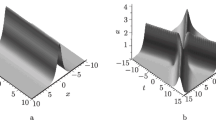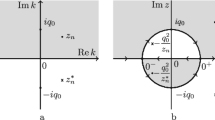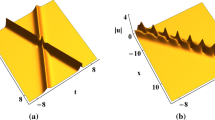Abstract
We use the Riemann–Hilbert (RH) method to study the Kundu-type nonlinear Schrödinger (Kundu–NLS) equation with a zero boundary condition in the case where the scattering coefficient has \(N\) distinct arbitrary-order poles. We perform a spectral analysis of the Lax pair and consider the asymptotic property, symmetry, and analyticity of the Jost solution. Based on these results, we formulate the RH problem whose solution allows solving the considered Kundu–NLS equation. In addition, using graphic analysis, we study the characteristics of soliton solutions of some particular cases of the problem with \(N\) distinct arbitrary-order poles.




Similar content being viewed by others
References
G. P. Agrawal, Nonlinear Fiber Optics, Acad. Press, San Diego (2001).
D. J. Benney, “A general theory for interactions between short and long waves,” Stud. Appl. Math., 56, 81–94 (1976).
T. Kakutani and K. Michihiro, “Marginal state of modulational instability: Note of Benjamin–Feir instability,” J. Phys. Soc. Japan., 52, 4129–4137 (1983).
H. Bailung and Y. Nakamura, “Observation of modulational instability in a multi-component plasma with negative ions,” J. Plasma Phys., 50, 231–242 (1993).
Y. S. Kivshar and G. P. Agrawal, Optical Solitons: From Fibers to Photonic Crystals, Acad. Press, New York (2003).
B. A. Malomed, D. Mihalache, F. Wise, and L. Torner, “Spatiotemporal optical solitons,” J. Opt. B, 7, R53–R72 (2005).
L. Pitaevskii and S. Stringari, Bose–Einstein Condensation and Superfluidity (Intl. Ser. Monogr. Phys., Vol. 164), Oxford Univ. Press, Oxford (2016).
G. Fanjoux, J. Michaud, H. Maillotte, and T. Sylvestre, “Cascaded Raman slow light and optical spatial solitons in Kerr media,” Phys. Rev. A., 87, 033838 (2013).
M. Li, J.-H. Xiao, W.-J. Liu, P. Wang, B. Qin, and B. Tian, “Mixed-type vector solitons of the \(N\)-coupled mixed derivative nonlinear Schrödinger equations form optical fibers,” Phys. Rev. E, 87, 032914 (2013).
F. G. Mertens, N. R. Quintero, and A. R. Bishop, “Nonlinear Schrödinger solitons oscillate under a constant external force,” Phys. Rev. E, 87, 032917 (2013).
J. T. Cole and Z. H. Musslimani, “Band gaps and lattice solitons for the higher-order nonlinear Schrödinger equation with a periodic potential,” Phys. Rev. A, 90, 013815 (2014).
A. Kundu, “Landau–Lifshitz and higher-order nonlinear systems gauge generated from nonlinear Schrödinger-type equations,” J. Math. Phys., 25, 3433–3438 (1984).
A. Kundu, “Integrable hierarchy of higher nonlinear Schrödinger type equations,” SIGMA, 2, 078 (2006).
X.-B. Wang and B. Han, “The Kundu-nonlinear Schrödinger equation: Breathers, rogue waves, and their dynamics,” J. Phys. Soc. Japan, 89, 014001 (2020).
C. Zhang, C. Li, and J. He, “Darboux transformation and rogue waves of the Kundu-nonlinear Schrödinger equation,” Math. Methods Appl. Sci., 38, 2411–2425 (2015).
X.-B. Wang and B. Han, “Inverse scattering transform of an extended nonlinear Schrödinger equation with nonzero boundary conditions and its multisoliton solutions,” J. Math. Anal. Appl., 487, 123968 (2020).
X.-W. Yan, “Riemann–Hilbert method and multi-soliton solutions of Kundu-nonlinear Schrödinger equation,” Nonlinear Dynam., 102, 2811–2819 (2020).
M. J. Ablowitz and P. A. Clarkson, Solutions, Nonlinear Evolution Equations, and Inverse Scattering (London Math. Soc. Lect. Note Ser., Vol. 149), Cambridge Univ. Press, Cambridge (1991).
V. B. Matveev and M. A. Salle, Darboux Transformations and Solitons (Springer Ser. Nonlin. Dyn., Vol. 5), Springer, Berlin (1991).
R. Hirota, The Direct Method in Soliton Theory (Cambridge Tracts Math., Vol. 155), Cambridge Univ. Press, Cambridge (2004).
G. W. Bluman and S. Kumei, Symmetries and Differential Equations (Appl. Math. Sci., Vol. 81), Springer, New York (1989).
C. S. Gardner, J. M. Greene, M. D. Kruskal, and R. M. Miura, “Method for solving the Korteweg–de Vries equation,” Phys. Rev. Lett., 19, 1095–1097 (1967).
E. Noether, “Invariante Variationsprobleme,” Nachr. Ges. Wiss. Göttingen, Math.-Phys. Kl., 2, 235–275 (1918).
C. J. Papchristou and B. K. Harrison, “A method for constructing a Lax pair for the Ernst equation,” Electron. J. Theor. Phys., 6, 29–40 (2009); http://www.ejtp.com/articles/ejtpv6i22p29.pdf (2009).
M. J. Ablowitz, D. J. Kaup, A. C. Newell, and H. Segur, “Nonlinear-evolution equations of physical significance,” Phys. Rev. Lett., 31, 125–127 (1973).
M. J. Ablowitz, D. J. Kaup, A. C. Newell, and H. Segur, “The inverse scattering transform–Fourier analysis for nonlinear problems,” Stud. Appl. Math., 53, 249–315 (1974).
R. Y. Chiao, E. Garmire, and C. H. Townes, “Self-trapping of optical beams,” Phys. Rev. Lett., 13, 479–481 (1965).
V. E. Zakharov, “Stability of periodic waves of finite amplitude on the surface of a deep fluid,” J. Appl. Mech. Tech. Phys., 9, 190–194 (1968).
A. Hasegawa and F. Tappert, “Transmission of stationary nonlinear optical pulses in dispersive dielectric fibers,” Appl. Phys. Lett., 23, 142–144 (1973).
V. E. Zakharov, S. V. Manakov, S. P. Novikov, and L. P. Pitaevskii, Theory of Solitons: Inverse Problem Method [in Russian], Nauka, Moscow (1980); English transl.: S. P. Novikov, S. V. Manakov, L. P. Pitaevskii, and V. E. Zakharov, Theory of Solitons: The Inverse Scattering Method, Consultants Bureau, New York (1984).
G. Biondini and G. Kovačič, “Inverse scattering transform for the focusing nonlinear Schrödinger equation with nonzero boundary conditions,” J. Math. Phys., 55, 031506 (2014).
X. Zhou, “The Riemann–Hilbert problem and inverse scattering,” SIAM J. Math. Anal., 20, 966–986 (1989).
M. Kashiwara, “The Riemann–Hilbert problem for holonomic systems,” Publ. Res. Inst. Math. Sci., 20, 319–365 (1984).
A. S. Fokas and V. E. Zakharov, “The dressing method and nonlocal Riemann–Hilbert problems,” J. Nonlinear Sci., 2, 109–134 (1992).
D.-S. Wang, D.-J. Zhang, and J. Yang, “Integrable properties of the general coupled nonlinear Schrödinger equations,” J. Math. Phys., 51, 023510 (2010).
S.-F. Tian, “The mixed coupled nonlinear Schrödinger equation on the half-line via the Fokas method,” Proc. Roy. Soc. London Ser. A, 472, 20160588 (2016).
X. Geng and J. Wu, “Riemann–Hilbert approach and \(N\)-soliton solutions for a generalized Sasa–Satsuma equation,” Wave Motion, 60, 62–72 (2016).
S.-F. Tian, “Initial-boundary value problems of the coupled modified Korteweg–de Vries equation on the half-line via the Fokas method,” J. Phys. A: Math. Theor., 50, 395204 (2017).
S.-F. Tian, “Initial-boundary value problems for the general coupled nonlinear Schrödinger equation on the interval via the Fokas method,” J. Differ. Equ., 262, 506–558 (2017).
W.-X. Ma, “Riemann–Hilbert problems and \(N\)-soliton solutions for a coupled mKdV system,” J. Geom. Phys., 132, 45–54 (2018).
Y. Zhang, J. Rao, Y. Cheng, and J. He, “Riemann–Hilbert method for the Wadati–Konno–Ichikawa equation: \(N\) simple poles and one higher-order pole,” Phys. D, 399, 173–185 (2019).
W. Peng, S. Tian, X. Wang, T. Zhang, and Y. Fang, “Riemann–Hilbert method and multi-soliton solutions for three-component coupled nonlinear Schrödinger equations,” J. Geom. Phys., 146, 103508 (2019).
J.-J. Yang, S.-F. Tian, and Z.-Q. Li, “Riemann–Hilbert approach to the inhomogeneous fifth-order nonlinear Schrödinger equation with non-vanishing boundary conditions,” arXiv:2001.08597v1 [nlin.SI] (2020).
P. Zhao and E. Fan, “Finite gap integration of the derivative nonlinear Schrödinger equation: A Riemann–Hilbert method,” Phys. D, 402, 132213 (2020).
C. Zhang, C. Li, and J. He, “Rogue waves of the Kundu-nonlinear Schrödinger equation,” Open. J. Appl. Sci., 3, 94–98 (2013).
A. S. Fokas, “A unified transform method for solving linear and certain nonlinear PDEs,” Proc. Roy. Soc. London Ser. A, 453, 1411–1443 (1997).
Acknowledgments
The authors sincerely thank the editor and referees for their valuable comments.
Funding
This research was supported by the National Natural Science Foundation of China (Grant No. 11975306), the Natural Science Foundation of Jiangsu Province (Grant No. BK20181351), the Six Talent Peaks Project in Jiangsu Province (Grant No. JY-059), and the Fundamental Research Fund for the Central Universities (Grant Nos. 2019ZDPY07 and 2019QNA35).
Author information
Authors and Affiliations
Corresponding author
Ethics declarations
The authors declare no conflicts of interest.
Additional information
Translated from Teoreticheskaya i Matematicheskaya Fizika, 2021, Vol. 207, pp. 23-43 https://doi.org/10.4213/tmf10015.
Rights and permissions
About this article
Cite this article
Wang, ZY., Tian, SF. & Zhang, XF. Riemann–Hilbert problem for the Kundu-type nonlinear Schrödinger equation with \(N\) distinct arbitrary-order poles. Theor Math Phys 207, 415–433 (2021). https://doi.org/10.1134/S0040577921040024
Received:
Revised:
Accepted:
Published:
Issue Date:
DOI: https://doi.org/10.1134/S0040577921040024




